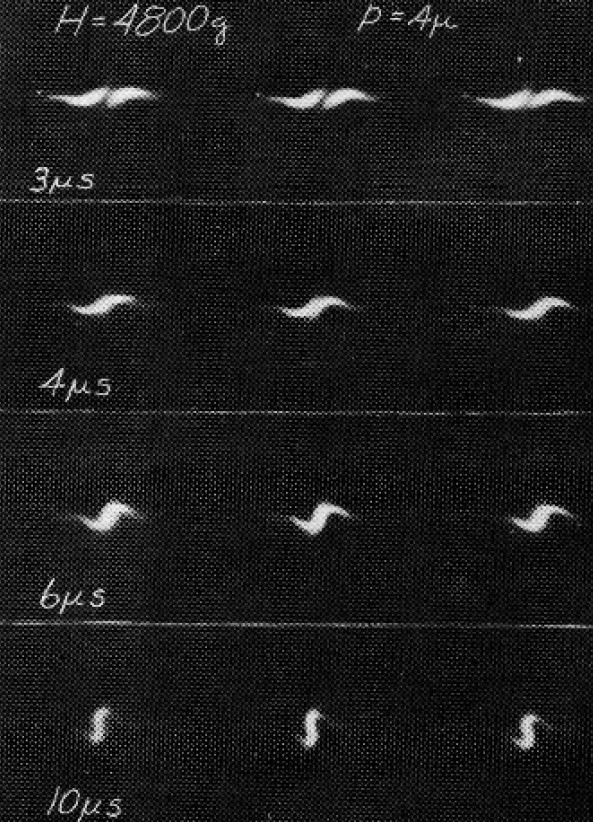A plasmoid is a coherent structure of plasma and magnetic fields. Plasmoids have been proposed to explain natural phenomena such as ball lightning,[2] magnetic bubbles in the magnetosphere,[3] and objects in cometary tails,[4] in the solar wind,[5][6] in the solar atmosphere,[7] and in the heliospheric current sheet. Plasmoids produced in the laboratory include field-reversed configurations, spheromaks, and the dense plasma focus.
The word plasmoid was coined in 1956 by Winston H. Bostick (1916-1991) to mean a “plasma-magnetic entity”:[8]
The plasma is emitted not as an amorphous blob, but in the form of a torus. We shall take the liberty of calling this toroidal structure a plasmoid, a word which means plasma-magnetic entity. The word plasmoid will be employed as a generic term for all plasma-magnetic entities.
Plasmoid characteristics
Bostick wrote:[8]
Plasmoids appear to be plasma cylinders elongated in the direction of the magnetic field. Plasmoids possess a measurable magnetic moment, a measurable translational speed, a transverse electric field, and a measurable size. Plasmoids can interact with each other, seemingly by reflecting off one another. Their orbits can also be made to curve toward one another. Plasmoids can be made to spiral to a stop if projected into a gas at about 10−3 mm Hg pressure. Plasmoids can also be made to smash each other into fragments. There is some scant evidence to support the hypothesis that they undergo fission and possess spin.
Cosmic applications
Bostick went on to apply his theory of plasmoids to astrophysical phenomena. His 1958 paper,[9] applied plasma similarity transformations to pairs of plasmoids fired from a plasma gun (dense plasma focus device) that interact in such a way as to simulate galaxy formation.[10][1] (See image top right)
Simple Plasmoid Generation
It is relatively easy to generate a plasmoid using a microwave and a medium that will initiate the formation of a plasmoid,[11] this can be caused by the carbon microparticles in the smoke from a naked flame or match, which ignites and moves about as plasmoids, and some biological cells are known to produce plasma under microwave conditions, such as grapes[12] (electrons try to move through highly resistive grape-skin, and plasmoids may form[11]) This is due to the fact that microwaves, being high frequency electromagnetic radiation in the GHz range, are capable of exciting electrodeless gas discharges in air,[13] similar to the process used in Sulfur lamps. Microwave-excited plasmas have two appealing properties:
- If applied in surface-wave-sustained mode, they are especially well suited to generate large-area plasmas of high plasma density.
- Both in surface-wave and resonator mode, they can exhibit a high degree of spatial localisation. This allows to spatially separate the location of plasma generation from the location of surface processing, see afterglow plasma. Such a separation, together with an appropriate gas-flow scheme, may help reduce the negative effect that particles released from a processed substrate may have on the plasma chemistry of the gas phase.
Footnotes
- ↑ 1.0 1.1 Bostick, W. H., “What laboratory-produced plasma structures can contribute to the understanding of cosmic structures both large and small” (1986) IEEE Transactions on Plasma Science (ISSN 0093-3813), vol. PS-14, Dec. 1986, p. 703-717. PEER REVIEWED
- ↑ Silberg, Paul A., “Ball Lightning and Plasmoids”, (1962) Journal of Geophysical Research, Vol. 67, p.4941 PEER REVIEWED
- ↑ Hones, E. W., Jr., “The magnetotail – Its generation and dissipation”, (1976) Physics of solar planetary environments; Proceedings of the International Symposium on Solar-Terrestrial Physics, Boulder, Colo., June 7-18, 1976. Volume 2.
- ↑ Roosen, R. G.; Brandt, J. C., “Possible Detection of Colliding Plasmoids in the Tail of Comet Kohoutek” (1976), Study of Comets, Proceedings of IAU Colloq. 25, held in Greenbelt, MD, 28 October – 1 November, 1974. Edited by B. D. Donn, M. Mumma, W. Jackson, M. A’Hearn, and R. Harrington. National Aeronautics and Space Administration SP 393, 1976., p.378
- ↑ Lemaire, J.; Roth, M., Differences between solar wind plasmoids and ideal magnetohydrodynamic filaments Planetary and Space Science, Volume 29, Issue 8, p. 843-849 PEER REVIEWED
- ↑ Wang, S.; Lee, L. C.; Wei, C. Q.; Akasofu, S.-I., A mechanism for the formation of plasmoids and kink waves in the heliospheric current sheet (1988) Solar Physics (ISSN 0038-0938), vol. 117, no. 1, 1988, p. 157-169. PEER REVIEWED
- ↑ Cargill, P. J.; Pneuman, G. W., “The energy balance of plasmoids in the solar atmosphere“FULL TEXT (1986), Astrophysical Journal, Part 1 (ISSN 0004-637X), vol. 307, Aug. 15, 1986, p. 820-825. PEER REVIEWED
- ↑ 8.0 8.1 Bostick, Winston H., “Experimental Study of Ionized Matter Projected across a Magnetic Field“, (1956) Physical Review, vol. 104, Issue 2, pp. 292-299. PEER REVIEWED
- ↑ Bostick, Winston H., “Possible Hydromagnetic Simulation of Cosmical Phenomena in the Laboratory“FULL TEXT (1958) Cosmical Gas Dynamics, Proceedings from IAU Symposium no. 8. Edited by Johannes Martinus Burgers and Richard Nelson Thomas. International Astronomical Union. Symposium no. 8, p. 1090
- ↑ W. L. Laurence, “Physicist creates universe in a test tube,” New York Times, p. 1, Dec. 12, 1956.
- ↑ 11.0 11.1 Heather Hosack, Nathan Marler, and Dan MacIsaac Microwave Mischief and Madness THE PHYSICS TEACHER Vol. 40, May 2002, Department of Physics & Astronomy, Northern Arizona University
- ↑ Slow Motion Plasma In The Microwave Video Link
- ↑ Karl D. Stephan Microwave generation of stable atmospheric-pressure fireballs in air (2006) Phys. Rev. E 74, 055401(R) PEER REVIEWED
References
- Bostick, W. H., “Experimental Study of Plasmoids“,FULL TEXT Electromagnetic Phenomena in Cosmical Physics, (1958) Proceedings from IAU Symposium no. 6. Edited by Bo Lehnert. International Astronomical Union. Symposium no. 6, Cambridge University Press, p.87
